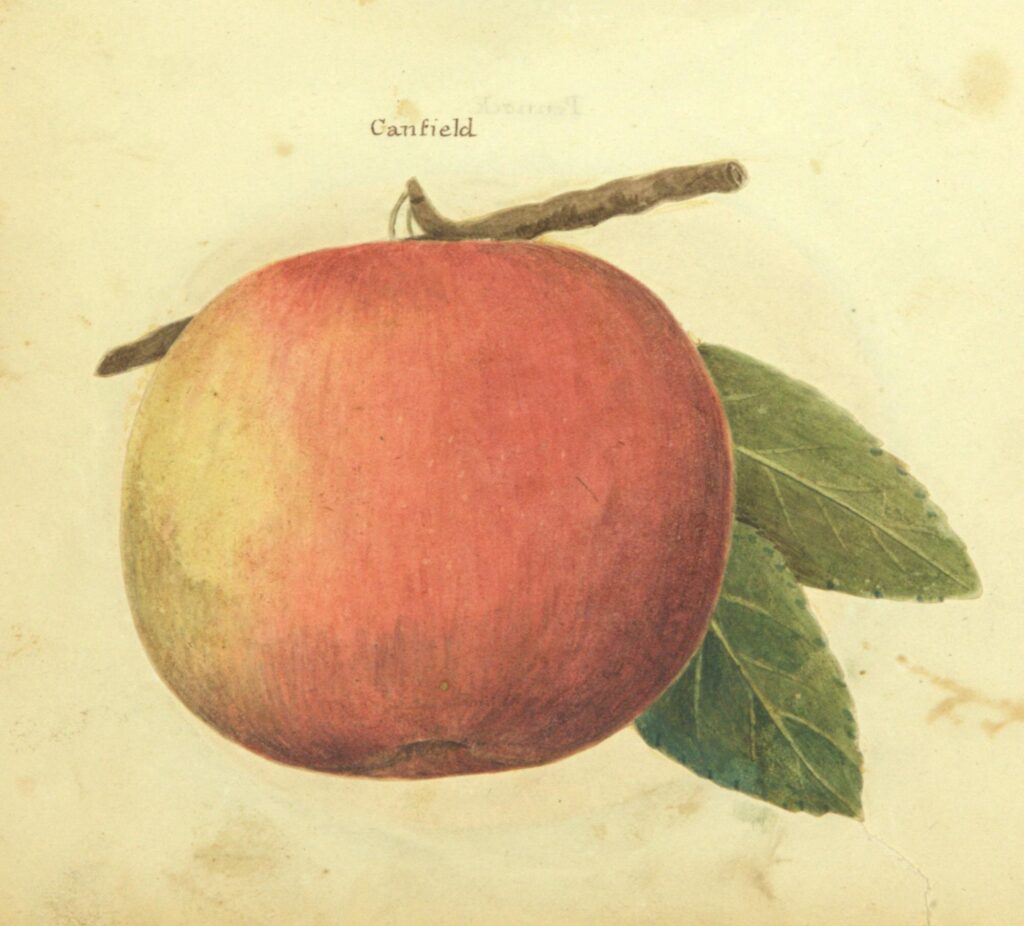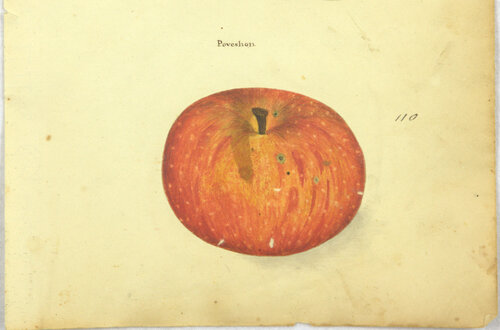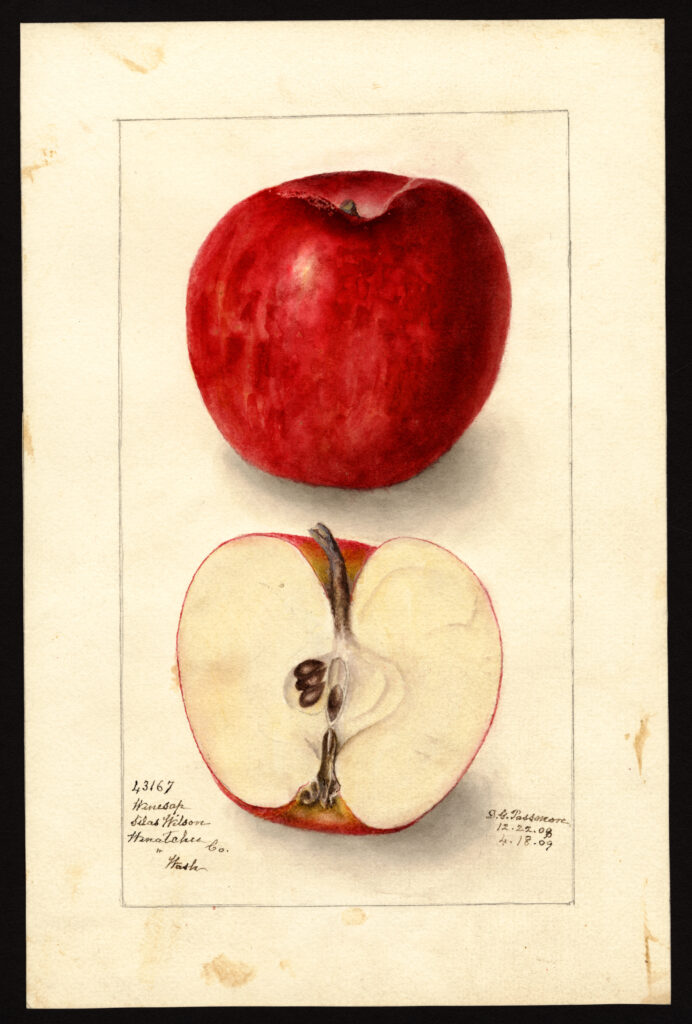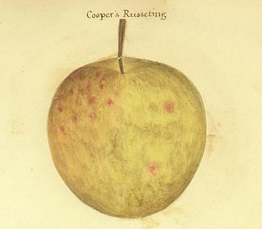Apple Varieties
There are more than 16,000 varieties of apples known to have been cultivated in North America. While many of these varieties are lost, there are still growers in New Jersey and around the United States growing more than the few common grocery store varieties.
Across New Jersey more than fifty apple varieties are grown, including Braeburn, Golden & Red Delicious, Fuji, Gala, Jonagold, Rome Beauty, Granny Smith, Winesap, McIntosh, Pink Lady, Cameo, York, Ginger Gold, and more.
In Burlington orchardist William Coxe’s 1817 book A View of the Cultivation of Fruit Trees, he identifies the following varieties of table and cider apples.
Table Apples
1. Junating
2. Princes Harvest
3. Bough
4. Summer
5. Early Pearmain
6. Summer Rose
7. Codling
8. Maidens Blus
9. Hagloe Crab
10. Catline
11. Romanite, or Ram
12. Fall Pippin
13. Doctor Apple
14. Wine
15. Late Pearmain
16. Burlington Green
17. Bellflower
18. Newark Pippin
19. Pennock
20. Michael Henry
21. Spitzemberg
22. Newton Pippin
23. Priestly
24. Pomme d’Apis/Lady Apple
25. Carthouse,
26. Tewksbury Winter Blush
Cider Apples
1. Hewes’s Crab
2. House, or Greyhouse
3. Winesap
4. Harrison
5. Styre.
6. Roanes White Crab
7. Gloucester White
8. Redstreak
9. Campfield
10. American Pippin
11. Golden Rennet
12. Hagloe Crab
13. Coopers Russeting
14. Ruckmans Pearmain.

Historic New Jersey Cider Apple Varieties
Below are images of the cider apple varieties described by William Coxe in his 1817 book, along with the descriptions.

Harrison
This is the most celebrated of the cider apples of Newark in New-Jersey: it is cultivated in high perfection, and to a great extent in that neighbourhood, particularly on the Orange mountain; the shape is rather long, and pointed towards the crown-the stalk long; hence it is often called the long stem-the ends are deeply hollowed; the skin is yellow, with many small but distinct black spots, which give a roughness to the touch: the flesh is rich, yellow, firm and tough; the taste pleasant and sprightly, but rather dry-it produces a high coloured, rich, and sweet cider of great strength, commanding a high price in New-York, frequently ten dollars and upwards per barrel when fined for bottling. The trees are certain bearers; the apples fall about the first of November; hey are below the middling size, remarkably free from rot; ripen at that time, but will keep well when housed. The tree is of strong and vigorous growth, throwing out numerous suckers from the limbs-the wood is hard-ten bushels are required for a barrel of cider-one barrel will produce fourteen quarts of distilled spirits : it obtained its name from a family in Essex county New-Jersey, where it originated, and is very extensively cultivated. One tree of this kind this year, in an orchard in Essex county, produced do upwards of 100 bushels, 87 of which were gathered when fully ripe, the others were fallen fruit, careful ally measured to ascertain the quantity.


Granniwinkle
This apple is of moderate size, in form rather ob long the skin a dark red, somewhat rough-the flesh a dead sweet, very rich, of a yellow colour. The cider produced from this apple, resembles a sirup in its taste and consistence-it originated in one of the East ern counties of New-Jersey, and obtained its name from a farmer who first cultivated it: it is usually mix ed with the Harrison for making cider of a superior quality it ripens in the month of November.


Campfield or Newark Sweeting
This apple is next in reputation as a cider fruit to the Harrison; and is usually mixed with that apple equal portions when ground: the size is middling, the skin is smooth and red, with small indistinct yellow spots, the side from the sun a greenish yellow: the flesh is white, firm, sweet and rich; the form is round, flattened, and somewhat sunk at the ends-the cider is very strong and highly flavoured, yielding fourteen quarts of spirit from a barrel-the price of the cider, about a dollar per barrel less than the Harrison. The form of the tree is tall, with straight limbs, inclining upwards; the size large, the growth very vigorous, the wood hard, and of uncommon fruitfulness; it is esteemed the most profitable apple produced in the Eastern counties of this State, where it was originally cultivated, and derived its name from a resident family in that part of the country.


Poveshon
This is a fine cider fruit in September and October, when it ripens and falls from the tree. The size is small, the form flat, the skin smooth and of a deep red with rich yellow flesh, which is sweet, and uncom monly dry. The skin of this apple is full of dark red blotches running longitudinally, with small white spots: the tree grows very straight, with upright branches, and is a great bearer. It is celebrated for making fine early cider in Essex county New-Jersey, where it was first cultivated, and derives its name from the family who brought it into notice.


Hewes Crab
This apple is of very small size; the form nearly round, the stem long and thin, the skin a dull red, mix ed with faint streaks of greenish yellow, and numerous small white spots. The juice, although acid and aus tere to the taste when mixed with the flesh, becomes sweet and highly flavoured when expressed from the pulp in the perfect maturity of the fruit: the flesh is singularly fibrous and astringent; in pressing, it sepa rates from the liquor, which runs through the finest flan nel like spring water; in this state it may be trans ported a great distance to the cellar of the dealer, before the commencement of the fermentation-it is not practicable to express the juice sufficiently from the pomace, in one operation of the press; it is therefore usually returned to the vat, and serves to make water cider of a very superiour quality—my own practice is, to mix the crab pomace in the vat with that of strong rich cider apples, which makes an improved liquor, by being strained through and absorbing much of the fine liquor of the crab. The tree is of small size, the leaves, though small, are of luxuriant growth-the wood hard and tough, never breaking with the load of fruit usually produced every second year-such is the hardiness of this fruit, that in its bearing year it re sists the frosts which frequently cut off our other apples: the origin of this apple is satisfactorily traced to Vir ginia, where trees nearly one hundred years old, are now standing in the orchard of a respectable inhabi tant of that State, from whom I obtained the informa tion. The size of the fruit may be increased by liberal manuring and good cultivation-I have hauled from one to three and four loads of meadow or river mud round many hundreds of my trees, with the best effect, in the increase both of the size and quantity of the fruit,


House, or Greyhouse
The Greyhouse, is thought to be the finest cider brought to the Philadelphia market, by the generality of the admirers of that liquor, with the exception of the Crab: in my own opinion, it does not surpass the Winesap, when well made-the form of the fruit is round, the size middling, a plump smooth skin of a dull red, mixed with faint streaks or blotches still more dull-the flesh is firm and dry, without much indica tion of its excellence in taste or smell: the cider when first made, is of sirupy richness; of great strength; and when well fined, of peculiar delicacy and purity. The tree is by no means hardy-nor is it a regular bearer, although it sometimes produces abundantly one of the finest orchards of this fruit, stands on a sub-soil of river mud; meadow and river mud have been found highly efficacious in promoting its growth. The fruit hangs late, and makes excellent cider with out housing-the must is very heavy, next in weight to that of the Coopers Russeting, which weighs twenty four dwt. per pint more than water.


Winesap
This is one of our best cider fruits, and is much es teemed as a good eating apple: the size is middling, the form round, lessening a little towards the crown: the skin is smooth, the colour a dark red, with a small portion of yellow, and sometimes a few streaks-the flesh is rich, yellow, and tolerably juicy, pleasant, and sweet; the cider produced from it is vinous, clear, and strong; equal to any fruit liquor of our country for bottling. The apples hang late, and make good cider without housing; they will however repay all the expense of complete maturation in an airy loft, by the increased flavour of the liquor-the tree is well adapted to light soils: of 100 trees I planted on a sandy blowing knoll eight years ago, and well cultivated, not one has died-every tree bears fine fair apples; it is becoming the most favorite cider fruit in West Jersey. The form of the tree is irregular, the branches often grow downwards, and render it difficult to train in a handsome shape; it bears more uniformly than any fruitful kind with which I am acquainted.


Styre
This is the most celebrated and extensively culti vated cider apple in England; and is also a good eating apple: the size is above middling, the colour of a pale yellowish white; the flesh is firm, and when fully ripe, of a fine flavour: the cider when produced from a light rich soil, is rich, highly flavoured and of a good body; its price in England is frequently four fold that of common sale cider-the fruit is pale rinded, but produces a high coloured liquor. The tree is of a singularly beautiful growth, remarkably beesom-headed, throwing out numerous straight lux uriant shoots, growing upwards from the crown, in the form of a willow pollard, running much to wood, and in deep soils, growing to a great size before it be comes fruitful : it suits sandy ground: by the end of September it is ripe in England, generally the mid dle of October is in common years the time of gather ing-by Mr. Knights experiments, the must out weighed all others except that of a new variety, produced by mixing the Lulham Green, and Siberian Crab: Marshall states, that nearly one third more of Styre apples are required to produce a barrel of cider, compared with common apples.
The Styres growing in my orchards, are as large as Newton Pippins, and remarkably fair; I have kept several of them free from rot to the latter end of Jan uary-from this experiment, I should venture to pro nounce them highly estimable for late cider.


Roanes White Crab
This apple I procured from Colonel John Roane of Virginia-the original tree was discovered a wil ding on his Estate, in the year 1790. In growth it resembles the Hewes’s crab; the leaves being very delicate, the wood hard, and the size of the tree small; it is an early and great bearer every second year: the apple is very small, not larger than the Hewes’s crab; the form is round, the stalk thin, the skin yellow, with a small portion of russet about the stem, and spots of red scattered over it: the flesh is rich, dry, and of a musky sweetness; rough to the taste, from its astringent and fibrous properties, and leaving the pomace undissolved after pressing: the liquor is re markably strong, of a sirupy consistence when first made, but becoming singularly bright by proper fer mentation and racking. It will keep perfectly sweet in casks well bunged, and placed in a cool cellar, through our summer months: the fruit ripens in Sep tember and October, and may be kept without rotting for late cider.


Gloucester White
This apple is of a middling size; of a shape not very uniform, varying from an oblong to a flat form the colour when ripe, is a bright yellow, with clouds of black spots: the flesh is yellow, rich, breaking, and juicy; of a fine flavour as a table apple, and producing cider of an exquisite taste. The stalk is of the ordi. nary length, inserted in a cavity of medium depth, the crown is moderately deep: the time of ripening is a bout the first of October, after which the fruit soon falls and is fit for cider. It does not keep long, but while in season, is a delicious table apple, the tree is very thrifty, hardy and vigorous; of a regular and beautiful form, and very productive. It is much cultivated in the lower counties of Virginia, from whence I procured it, as an apple of high reputation.


Redstreak
This tree was originally brought from England, where it possessed a high reputation as a cider fruit; it has been cultivated extensively in this country, by the descendants of the English settlers in New-York, New-Jersey, and Pennsylvania. The climate of America is supposed to have revived the character of this apple, which had deteriorated in its native soil, from the long duration of the variety-the fruit is ra ther small; the form is oblong, flattened at both ends, the stem and crown both sunk-the skin is red, faintly streaked and spotted with yellow-the flesh is yellow, rich, firm, and dry; it hangs late, and requires to be matured by housing to make the finest cider. The character of the cider, when properly made and fined, is very high, both for strength and flavour-the ap ple keeps well through the winter, and is much estee med as an excellent kitchen fruit in the latter part of winter. The tree is of handsome, regular growth, and a great bearer: the opinion of dealers is, that this cider is difficult to fine fit for bottling: when perfect ly cleared, it ranks among our first fruit liquors.


American Pippin
“This apple is in very high reputation, both for cider and for keeping till very late in the spring, often till Harvest. The shape is flat, without any hollow at the ends; the stem singularly thick and fleshy; the crown very large, the skin a dull red, with faint yel how spots, and a portion of dull green; the flesh hard and white; the tree is of a growth remarkably spreading. It makes cider nearly equal to the Grey-House: I am informed by an intelligent and experienced farmer, that fourteen bushels of this apple are required for a barrel of cider. In the season of bearing, it produces abundance of sound and fair fruit.”


Golden Rennet
This apple was originally imported from England. It is an excellent fruit for late cider: the size is small, the colour yellow, the skin covered with bright russet, rough to the touch; the flesh is rich, yellow, and highly flavoured; it ripens about the first of November: the tree is large, handsome, and spreading, and an abundant bearer.


Hagloe Crab
The character of this apple as a cider fruit, stands very high in Herefordshire, England, where the pa rent tree was standing in 1783, in the orchard of Mr. Bellamy of that county: the cider, as stated by Mr. Marshal, has been supposed to exceed, for richness, flavour, and price, any fruit liquor which nature and art have produced. Sixty guineas have been offered for a hogshead of a hundred and ten gallons; also bottle for bottle of wine and spirituous liquors, have been offered for it. The fruit, when fully ripe, has a yellow ground streaked with bright red-the size about middling, the form round, flat at the ends; the stalk large-the flesh remarkably soft and woolly, but not dry-the taste acid, but highly flavoured, the quantity of juice smaller, in proportion to the fibrous matter, than in most other apples, requiring near one third more of the Hagloes for a barrel of cider, than of common fruit: the juice, though uncommonly sheer, is singularly rich, and though the smell of the apple is faint, the flavour of the cider is high; and when pro perly manufactured, is very rich. The colour of the flesh is pale, but that of the cider dark-it ripens in August and September; keeps a long time without rotting-it bears abundantly and early: the growth of the tree is very uncommon; thick strong shoots; buds, particularly at the extremity of the branches, very large; the colour of the wood dark-the size of the tree small: the Hagloe is an uncommonly fine cooking apple; and from its great beauty and large size, added to its abundant bearing, is a valuable market fruit.


Coopers Russeting
This apple was first propagated from an antient tree in the possession of Mr. Joseph Cooper of Gloucester county, New-Jersey, who supposed it to be of Indian origin-of this fact, strong doubts are entertained. The apple is small, of a pale yellow colour, mixed with russet; the form is oblong, diminishing to wards the crown; the stem is singularly long and thin; the flesh is dry, rich, and sweet: the fruit hangs till about the first of November, it keeps well through the winter, and is an economical kitchen apple, requiring but little sugar. The cider is thought to be the strongest in our country: it is, when first made, of a sirupy consistence, continues so through the winter, and is sometimes difficult to fine-it is when properly ‘managed, a most exquisitely flavoured and vinous li quor-the must is uncommonly heavy, weighing twenty-four penny-weight in the pint heavier than water: the tree is of small and irregular growth, the branches shoot in every direction, and the wood being brittle, is apt to be broken from the weight of fruit: this fault may be remedied in a great degree, by pruning the la teral, and promoting the growth of the perpendicular shoots. The tree suits light rich soils, in which it grows vigorously, and bears abundantly.


Ruckmans Pearmain
Called in New-York and East-Jersey, the Ruck mans, or Dutch Pearmain; and in other places the Red Russet; is a most valuable apple for cider, and for family use: the size is middling, the form rather flat, the skin rough, with a large portion of bright russet, mingled with red towards the sun when fully ripe-the flesh is rich, tender, and rather dry-it is a great and uniform bearer; the tree grows luxuriantly, with strong shoots, and a close compact head-the fruit ripens in November, and keeps well through the winter.
